
1
First stage
Biology
Lec
/ 10
Abeer H. Alkhafaf
Nervous System
The Nervous system is the most complex system in the human body histologically
and physiologically. It is formed by interconnected a network of billions nerve cells
(neurons), assisted by much numerous glial cells. Each neuron has hundreds of
interconnections with other neurons, forming a very complex system for processing
communication and generating responses.
The nervous system is divided anatomically into:-
1- Central nervous system CNS consisting of:-
a- The brain (cerebrum and cerebellum).
b- The spinal cord.
2- Peripheral nervous system PNS consisting of:-
a- Nerves ( cranial, spinal, peripheral ).
b- Ganglia.
c- Nerve ending.
* Both Central and Peripheral tissue consists of two cell types:
1- Nerve cells or Neurons. 2- Glial cells.

2
Neurons
The Neuron or nerve cell is the functional unit in both CNS and PNS, which usually
show numerous long processes, they are responsible for the reception, transmission,
and processing of stimuli. Neurons respond to environmental changes (stimuli) by
altering the ionic gradient that exists between the inner and outer surfaces of their
membranes. Neurons and their processes vary in size and shape.
Functionally, neurons are classified according to the direction in which they transmit
impulses relative to the central nervous system into:-
a-
Sensory (afferent) neurons: carry impulses from peripheral sense receptors to
the CNS.
b-
Motor (efferent) neurons: transmit impulses from the CNS to effector organs
such as muscles and glands.
c-
Interneuron: forming a communicating network between sensory and motor
neurons.
Neuron structure consists of three parts:-
1- The cell body or Perikaryon. 2- Dendrites. 3- Axon.
The cell body ( Perikaryon )
The cell body which is the part of neuron that contain the nucleus and surrounding
cytoplasm, it is primarily a trophic center for the entire nerve cell. It is the receptive to
stimuli and it receives a great number of nerve endings of other nerve cells, the nucleus
is large, spherical, euchromatic (pale staining) with prominent nucleolus. Cell body
contains rough endoplasmic reticulum (RER), Golgi apparatus, and polyribosomes and
contains Nissl bodies (chromatophilic substance).
Dendrites
Dendrites are elongated processes specialized to receive stimuli from the environment,
sensory epithelial cells, or other neurons. They are short and divided like branches of a
tree; they are covered with many synapses and are the principal signal reception and
processing site on the neurons. The arborization increases the receptive area of the
cell, and the branches become much thinner with further division.
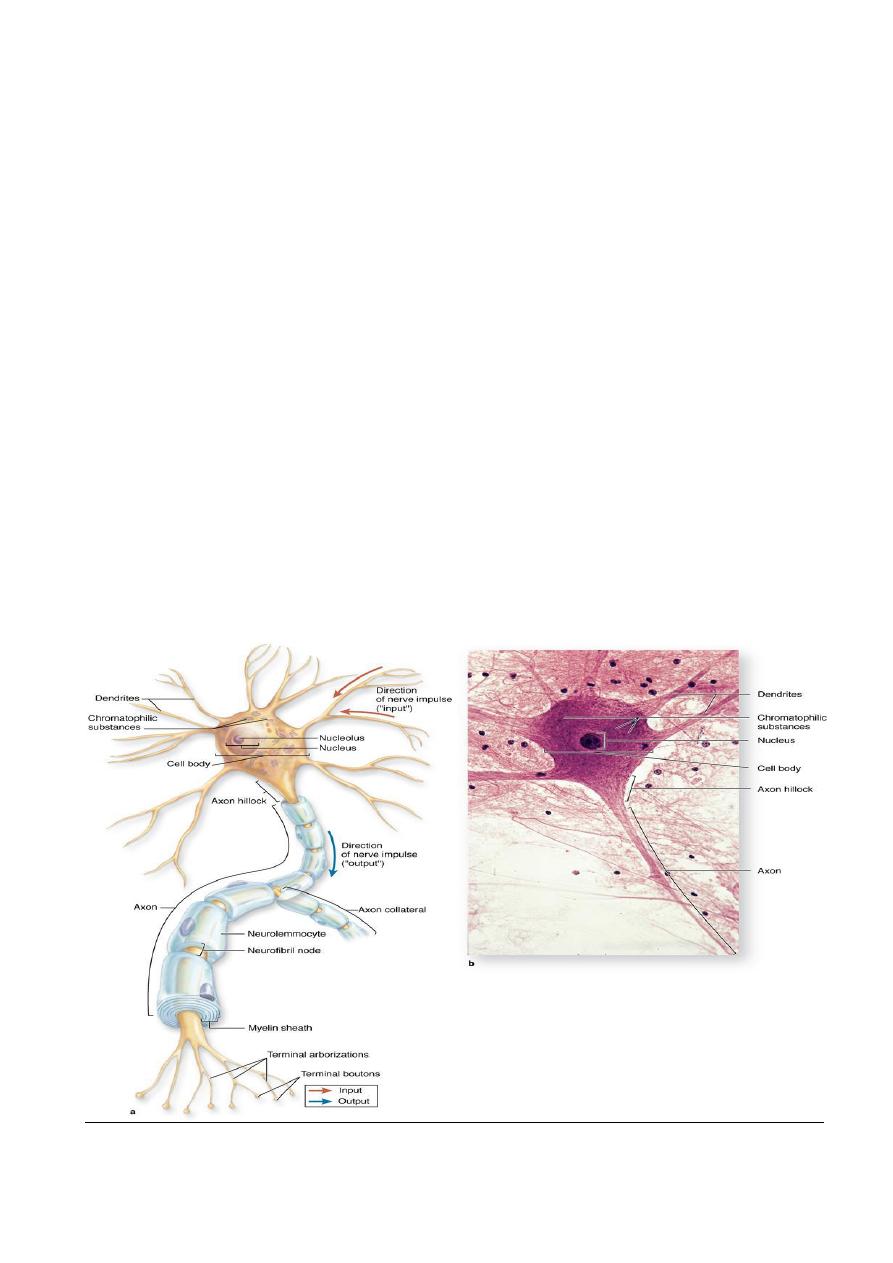
3
Axon
Axons are long, single, cylindrical processes that originate from a pyramid- shaped
region of the perikaryon; the Axon hillock, which is devoid of nissl bodies and Golgi
cisternae, and it is the site where all other organelles pass to the axon.
The plasma membrane of the axon is called Axolemma and the contents are known as
the axoplasm, which contains mitochondria, microtubules, some cisternae of SER, and
neurofilaments. RER and polyribosome are absent. The axon has a constant diameter
and varies in length and diameter according to the type of neuron.
The axon is specialized in generating and conducting nerve impulses to other cell
(nerve, muscle, gland cells), also may receive information from other neurons. The
distal portion of the axon is usually branched as terminal arborization, Each branch
terminates on the next cell in dilatations called End bulbs (boutons), which interact
with other neurons or non nerve cells at structures called Synapses which are
specialized junctions for the transmission of nerve impulses from neuron to another
neuron or other effector cell (muscle and gland) in unidirectional way.
Collateral branches: - are branches of the axon that connect with other group of cells.
Structures of neuron
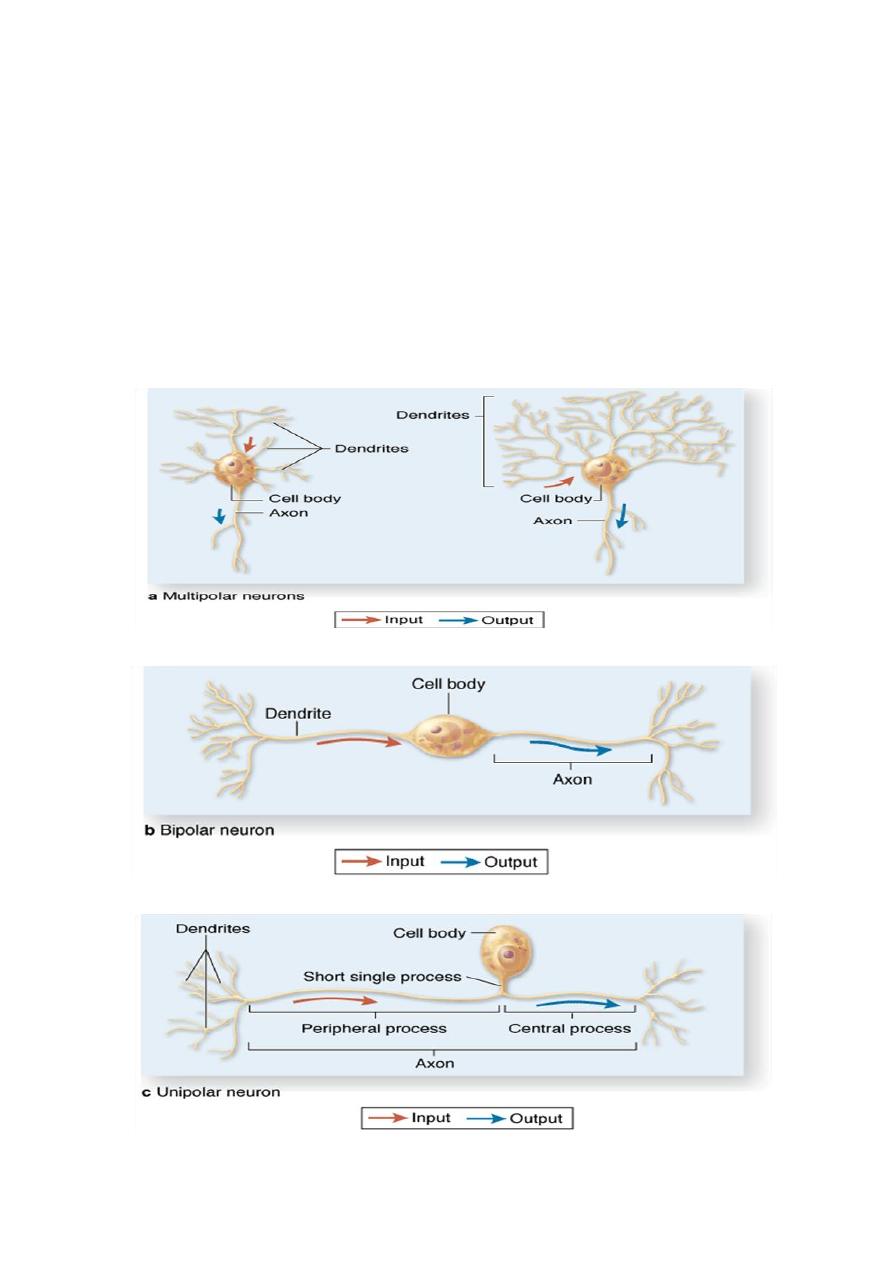
4
Neurons can be classified according to the number of processes extending from
the cell body into:-
a- Multipolar neurons, which have one axon and two or many dendrites, most
neurons are Multipolar.
b- Bipolar neurons, with one dendrite and one axon, found in the retina and the inner
ear.
d- Unipolar or pseudounipolar neurons, which have a single process that bifurcates
close to the cell body with the longer branch extending to a peripheral ending and the
other toward the CNS. Pseudounipolar found in spinal ganglia.
Structural classes of neurons
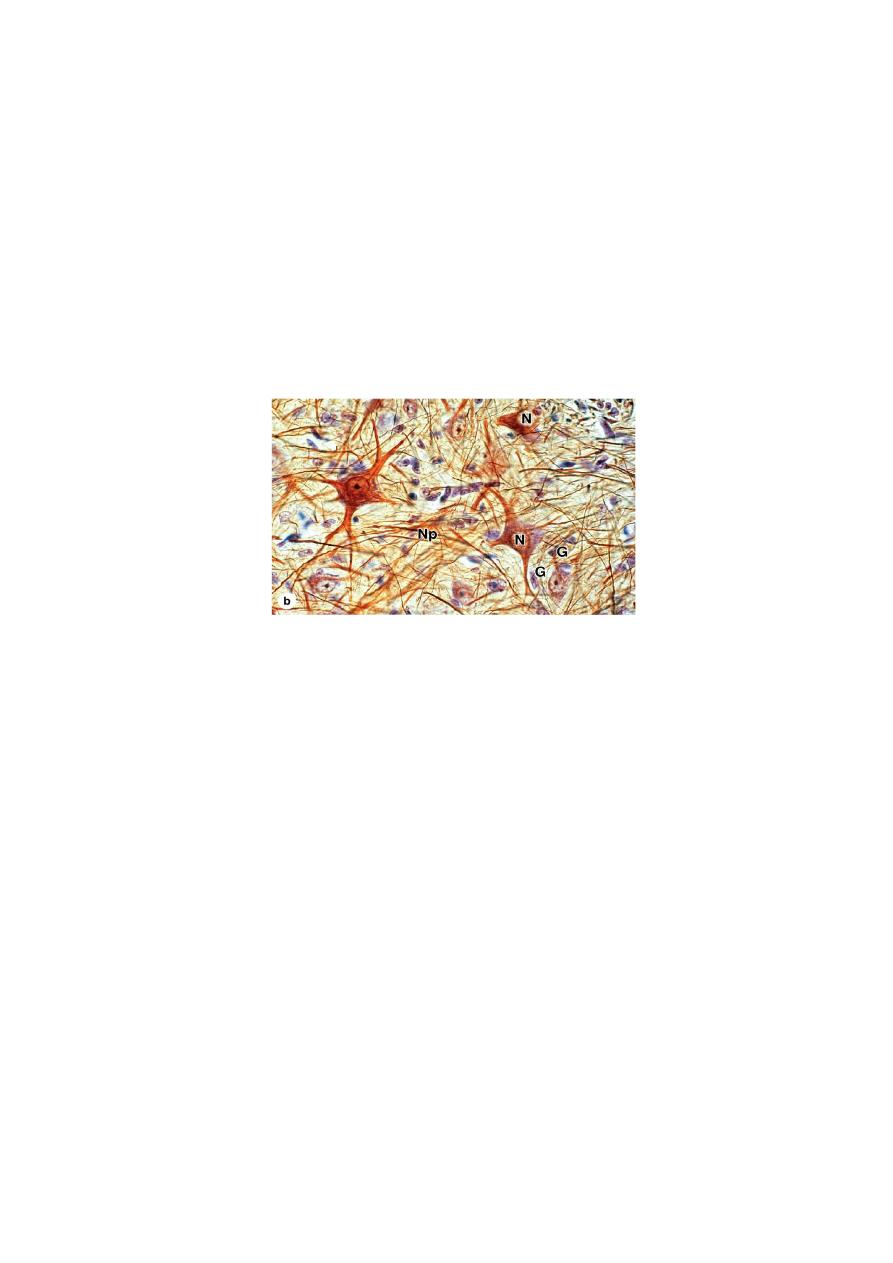
5
Glial cells ( Neuroglia )
Glial cells, which have short processes, support and protect neurons, and participate
in neural activity, neural nutrition, and the defence processes of the central nervous
system. They are 10 times more abundant in brain than the neurons. They are smaller
than neurons, and in the CNS they surround most of the neuronal cell bodies. They
provide an ideal environment for the neuronal activities.
In the CNS there is very little or no connective tissue. Instead, there is Neuropil, which
is dense network of fibers from processes of both neurons and glial cells fills the
interneuronal spaces of CNS.
Neuron, neuropil, and common glial cells
There are six kinds of glial cells:
1- Oligodendrocytes. 2- Astrocytes. 3- Ependymal cells.
4- Microglia cells. 5- Schwann cells. 6- Satellite cells.
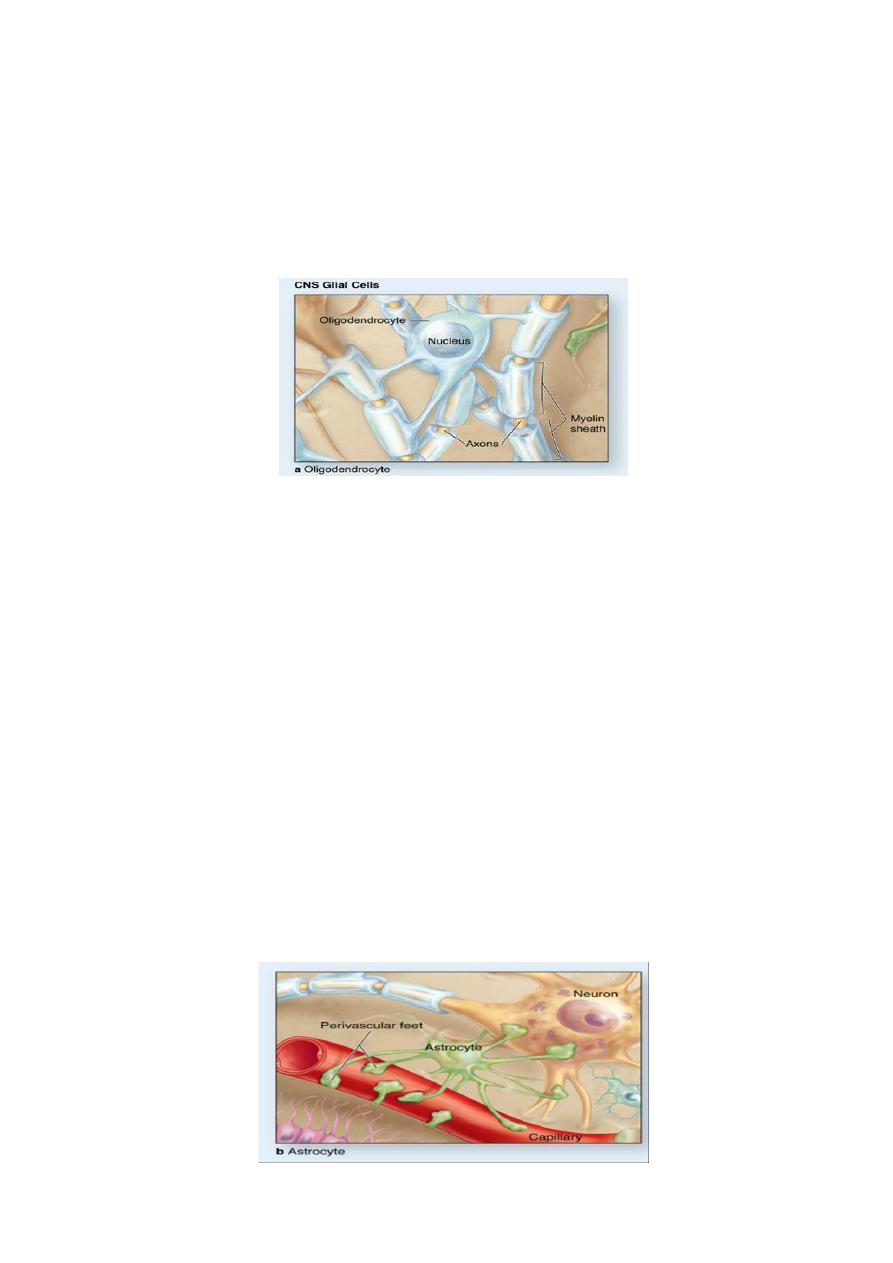
6
1- Oligodendrocytes
Oligodendrocytes are small cells with rounded, condensed nuclei and unstained
cytoplasm. They are predominant glial cell in CNS white matter, they produce the
myelin sheath that provide the electrical insulation for neurons in the CNS, and these
cells extend processes that form the myelin sheath wrap around many axons.
2- Astrocytes
Astrocytes are star-shaped cells, because of their multiple radiating processes, and they
are unique to the CNS. Astrocytes compared to other glial cells are by far the most
numerous and exhibit considerable morphological and functional diversity. In addition
to their supporting function, Astrocytes have major roles in controlling the ionic
environment of neurons, and they have processes that extend between blood vessels
and neurons, the processes are expanded, forming perivascular feet that cover capillary
endothelial cells and contribute to the Blood – Brain barrier.
Two kinds of astrocytes have been identified:-
- Protoplasmic astrocytes, which are more prevalent in the gray matter, have short
and branched processes.
- Fibrous astrocytes, which are more common in the white matter, have few and long
processes.
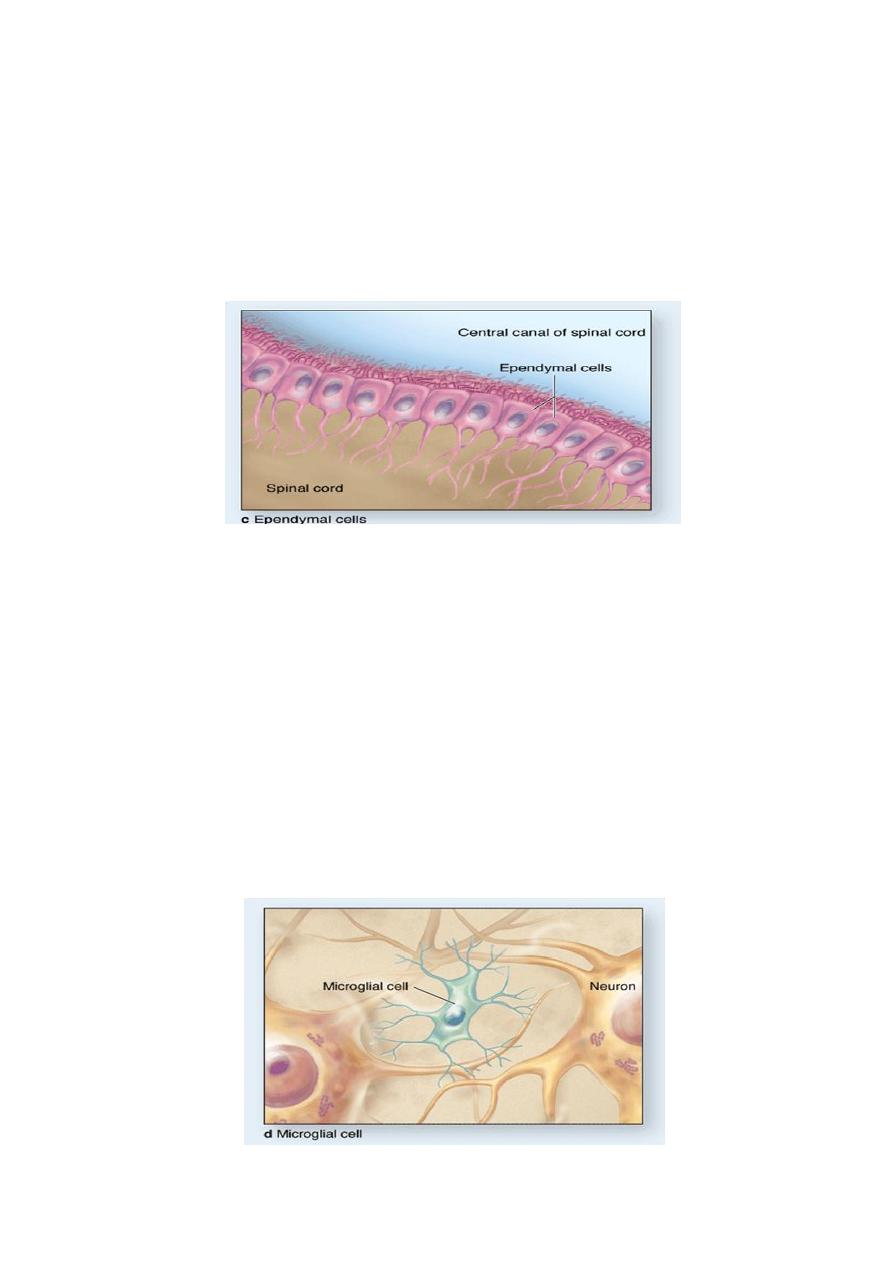
7
3- Ependymal cells
Ependymal cells are low columnar or cuboidal cells lining the ventricles of the brain
and central canal of the spinal cord. ependymal cells have cilia, which facilitate the
movement of the cerebrospinal fluid (CSF), or long microvilli which are involved in
absorption.
4- Microglia
Microglia are small cells with short irregular processes and less numerous than
oligodendrocytes or astrocytes cells, but more distributed throughout gray and white
matter, have dense elongated nuclei which contrast with the spherical nuclei of other
glial cells. Microglia are phagocytic cells, originate from blood monocytes and belongs
to the same family as macrophages and antigen presenting cells.
Microglia secrete a number of immunoregulatory cytokines and constitute the major
mechanism of immune defense in CNS tissues.
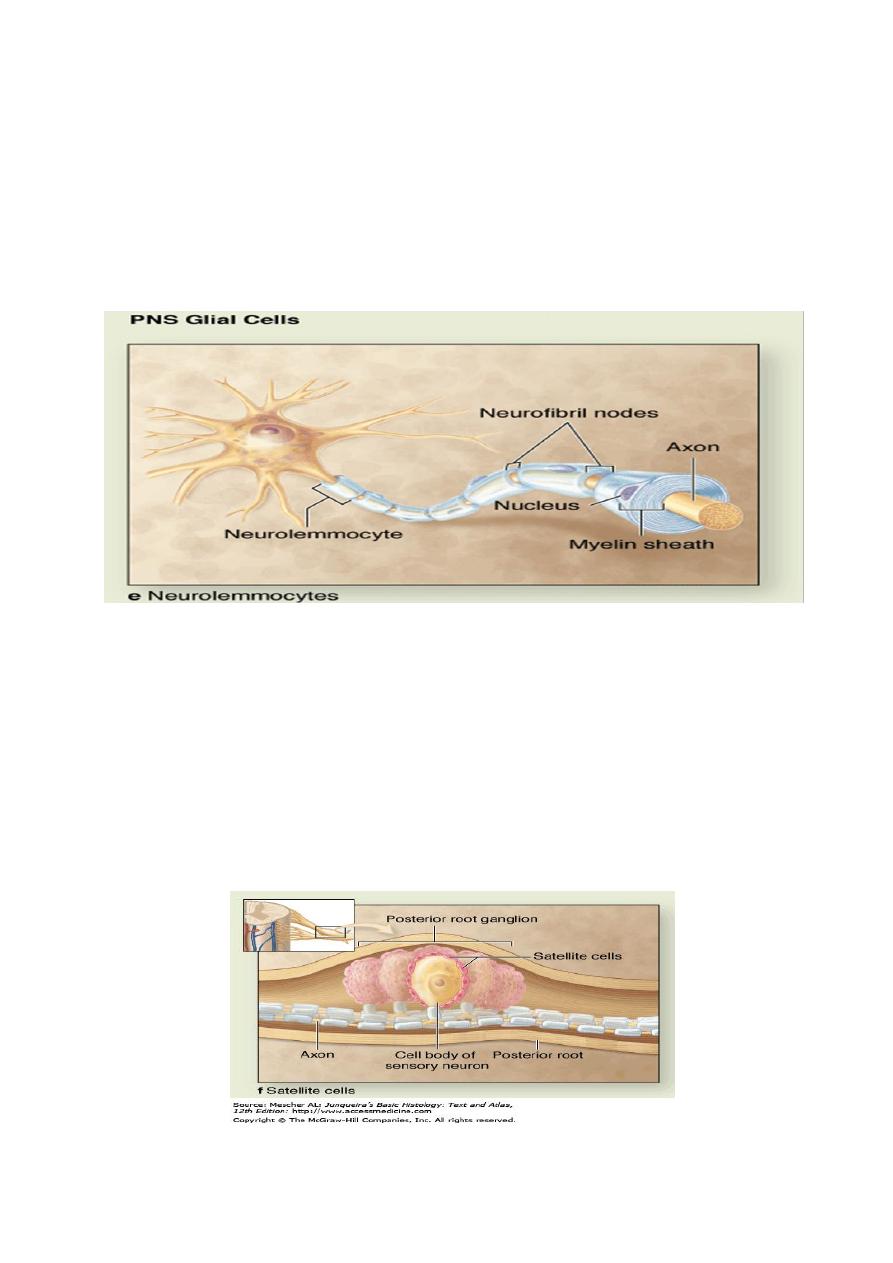
8
5- Schwann cells (Neurolemmocytes)
They are found only in PNS, and have trophic interactions with axons and allow for
their myelination, one Schwann cell forms myelin around a segment of one axon, in
contrast to the ability of oligodendrocytes to branch and sheath parts of more than one
axon.
6- Satellite cells of ganglia
Small satellite cells form a covering layer over the large neuronal cell bodies in PNS
ganglia. Closely associated with the neurons, the satellite cells exert a trophic or
supportive role.

9
First stage
Biology
Lec
/ 11
Abeer H. Alkhafaf
Central Nervous System
The principal structures of the CNS are:
1- The brain ( cerebrum and cerebellum ) which is enclosed in the skull.
2- Spinal cord which is contained within the vertebral canal.
It is soft and gel like organ because there is no connective tissue, in freshly sectioned
tissues ( cerebrum cerebellum and spinal cord ) show regions of white (white matter)
and gray (gray matter). This difference in color is due to the distribution of the nerve
cell bodies, glial cells and the myelinated nerve axons.
The white matter is composed mainly of the myelinated axons and the myelin-
producing oligodendrocytes. It does not contain neuronal cell body, but microglia are
present.
Gray matter is composed mainly of the nerve cell bodies, dendrites, the initial
unmyelinated portions of axon, astrocytes and the glial cells. This is the region where
synapses occur. Aggregates of neuronal cell bodies forming island of gray matter
embedded in the white matter are called nuclei.
Gray matter prevalent mainly at cortex of cerebrum and cerebellum, and the white
matter present in the central region.
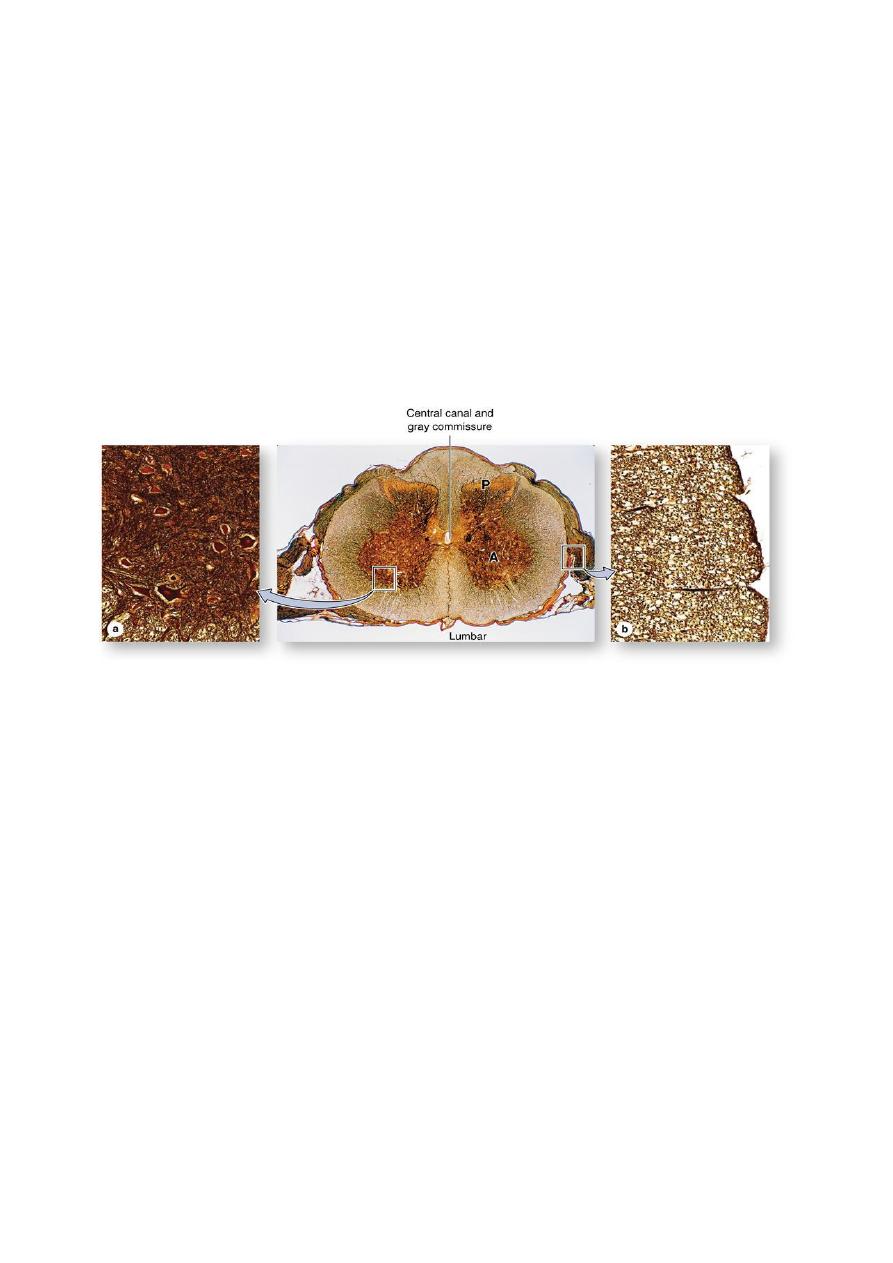
10
In cross section of the spinal cord, white matter is peripheral and gray matter is
internal and has general shape of an H (butterfly shape). In the center is an opening
of the central canal. The gray matter forms:
- The anterior horns, which contain the motor neurons whose axon make up the ventral
roots of spinal nerves.
- The posterior horns which receive sensory fibers from neurons in the spinal ganglia
(dorsal root).
Spinal cord neurons are large and multipolar, especially the motor neurons in the
anterior horns.
Spinal cord
. (P) horns (sensory) and two anterior (A) (motor) horns all joined by the gray commissure around the central canal. (a): The gray matter
(b): The white matter
Meninges
The skull and the vertebral column protect the CNS. The meninges are membranes of
connective tissue that present between the bone and nervous tissue, which are invest
and protect the brain and spinal cord. Three meningial layers distinguished; the dura
mater, the arachnoid and the delicate pia mater.
Blood Brain Barrier
Blood Brain Barrier (BBB) is a functional barrier that prevents the passage of some
substances, such as antibiotics and chemicals and bacterial toxic matter, from blood to
the nerve tissue, and maintains a constant environment. The main structural component
of the BBB is capillary endothelium.
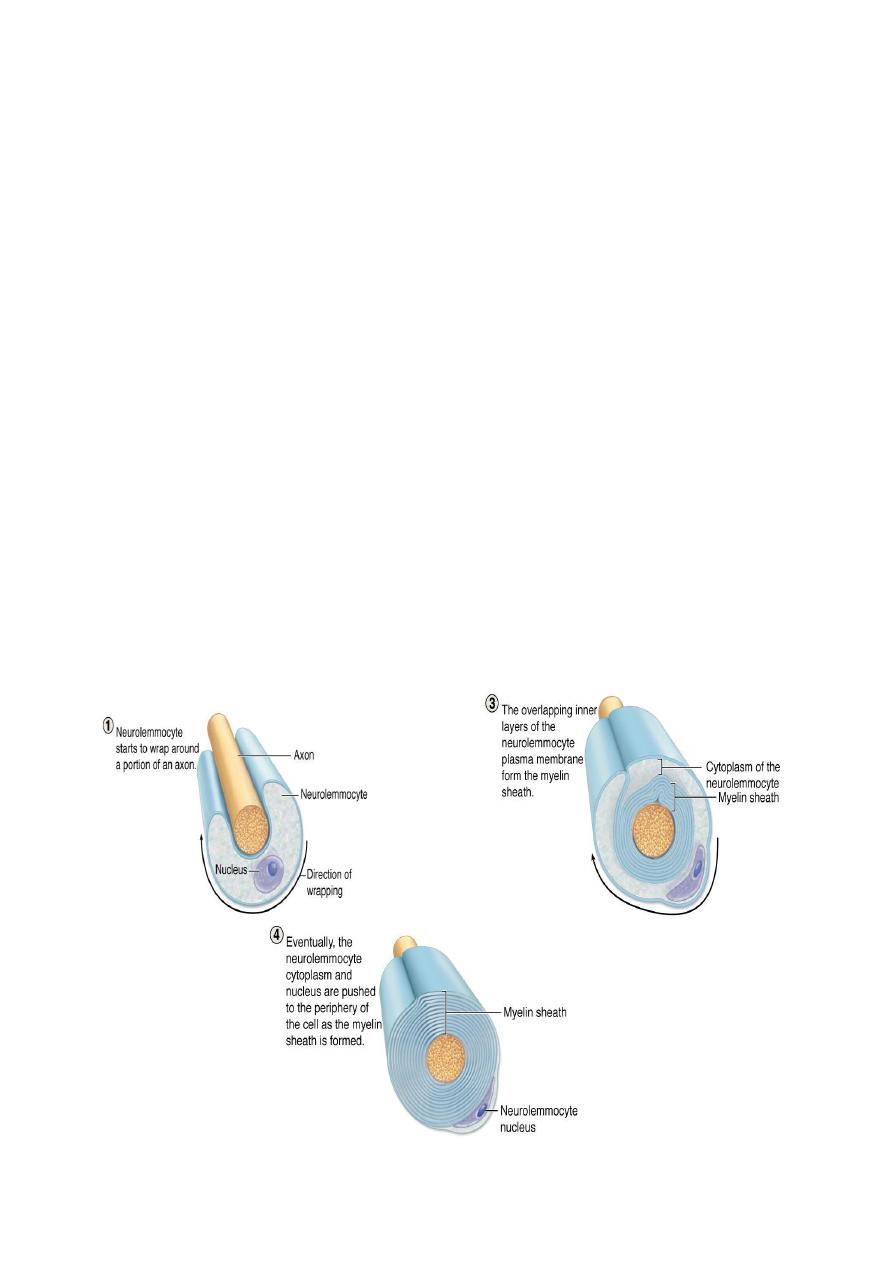
11
Peripheral Nervous System
The main components of PNS are:-
1- Nerves. 2- Ganglia. 3- Nerve endings.
Nerves are bundles of nerve fibers (axons) surrounded by glial cells and C.T.
Nerve fibers
In PNS nerve fibers consist of axons sheathed by schwann cells and it is divided into:
1- Myelinated nerve fibers
The multiple layers of Schwann cell membrane unite as a myelin layer. Myelin sheath
is a lipid layer, It is composed of concentrically wrapped layers of plasma membrane
of Schwann cells (Neurolemmocytes), pushing the nucleus and cytoplasm to the
periphery. Between adjacent Schwann cells the myelin sheath shows small nodal gaps
along the axon called the node of Ranvier devoid of myelin. The distance between
two nodes is called an "Internode" and consists of one Schwann. The Myelin sheath is
segmented due to numerous Schwann cells arranged along the length of the axon.
Myelin sheath serves to protect axons and maintain a constant ionic environment
required for action potentials.
Myelination of PNS axons
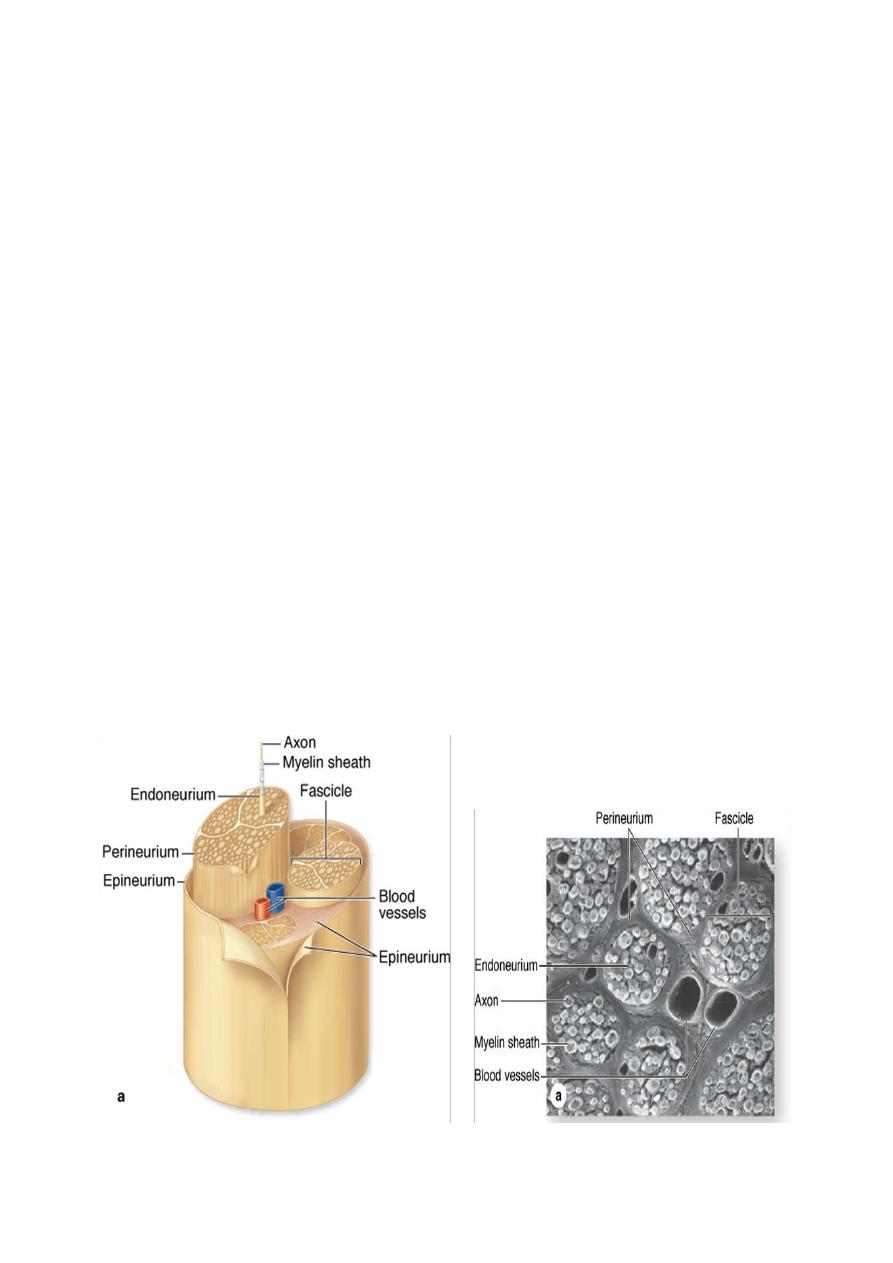
12
1- Unmyelinated nerve fibers
The Unmyelinated nerve fibers are more abundant in the CNS, where axons run free,
while in the PNS the axons are enveloped within simple folds of Schwann cells.
Peripheral nerves
In PNS nerve fibers are grouped into bundles to form nerves ( Myelinated and
Unmyelinated ). They have a whitish, glistening appearance because of their myelin
and collagen content. The nerves establish communication between centers in the brain
and spinal cord and the sense organs and effectors (muscles, glands, etc) by containing
both afferent and efferent fibers.
Axons and Schwann cells of nerves are enclosed within connective tissue layers:
1- Epineurium: which is an external dense irregular fibrous coat of C.T., which
surrounded the bundles of nerve fibers.
2- Perineurium: a sleeve of specialized C.T. formed by layers of flattened
epithelium-like cells surrounded each bundle.
3- Endoneurium: is thin layer of C.T. within the perineurial sheath run the
Schwann cell – sheathed axons.
Peripheral nerve connective tissue

13
Ganglia
Ganglia are small group of nerve cells outside the CNS. They are nodular masses of
neuronal cell bodies, glial cells and Satellite cells supporting by C.T, ganglia transmit
nerve impulses. According the direction of the nerve impulse, there are two kinds of
ganglia in the PNS:
1- Sensory ganglia: It receives afferent impulses that go to the CNS. The neurons of
these ganglia are pseudounipolar neurons and relay information from the
ganglion's nerve endings to the gray matter of the spinal cord via synapses with
local neurons. Satellite cells surround ganglion cells with large number.
* The sensory ganglia include:
- Cranial ganglia, which are associated with some of the cranial nerves.
- Spinal ganglia, which are associated with dorsal root of the spinal nerve.
2- Autonomic ganglia: which are small bulbous dilatations in autonomic nerves. The
neurons of these ganglia are multipolar. Satellite cells are less in number than the
sensory ganglion. The autonomic nerves are effect the activity of smooth muscle,
secretion of some glands, and the modulation of cardiac rhythm. It’s function to
maintain constant internal environment ( homeostasis ).
Autonomic nerves comprise an autonomic nervous system, classified into:
- Sympathetic division.
- Parasympathetic division.
Sympathetic division it is that part of the autonomic nervous system consisting of
nerves that located in the thoracic and lumbar regions of the spinal cord, and
functioning in opposition to the parasympathetic division, in which neurons are
found in small ganglia located near or within the effector organs, for example in the
walls of stomach and intestines.
